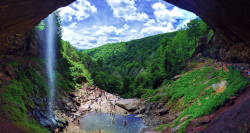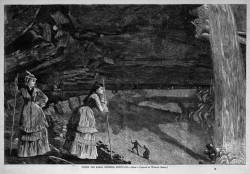Caves Behind Waterfalls


This is not a geological term, simply a description. A cave behind a waterfall is fascinating, a frequently recurring theme in literature. On the one hand, the massive wall of water blocking the exit is fascinating, and on the other, the fact that the cave remains invisible until you have passed through the waterfall.
And yet it is very common for waterfalls to form a cave, which is created by the waterfall and is also responsible for the existence of the waterfall. Ultimately, everything is based on layers of rock with different resistance to erosion. The hard layer weathers more slowly, the softer layer is eroded, the hard layer on top forms a cave underneath. A body of water intensifies the weathering, the water dissolves minerals, freezes in crevices and expands, resulting in frost heave. When the waterfall reaches a certain height, the force of the falling water erodes the rock at the point of impact. A hollow is formed that is filled with water called plunge pool. The water also transports debris away. And finally, the layer is undermined until it eventually breaks off under its own weight. In this way, the waterfall moves upstream and the step remains intact instead of being flattened over time.
The aspect of movement, the travelling waterfall, is difficult to imagine. This effect, which geologists call retrograde erosion, can be seen very dramatically at Niagara Falls. Here the river has dug far into the plateau, above the falls it flows on top of the plateau, below the falls in a gorge created by this retrograde movement. There was also a cave, which was a tourist attraction a hundred years ago. However, just as described, the rock collapsed and the waterfall moved a little further, so at the moment you can’t see a cave until the tireless waterfall has dug a new one. This process is quite rapid for a geological process, so the erosion at Niagara Falls in historical times is well documented at almost 2 metres per year.
- Examples
 Kaaterskill Falls, United States of America
Kaaterskill Falls, United States of America Dilek Magarasi, Turkey
Dilek Magarasi, Turkey Silver Stream Cave, China
Silver Stream Cave, China Ventanas de Tisquizoque, Colombia
Ventanas de Tisquizoque, Colombia Noccalula Falls, United States of America
Noccalula Falls, United States of America Cave of the Winds, United States of America
Cave of the Winds, United States of America Salto El Sapo, Venezuela
Salto El Sapo, Venezuela Seljalandsfoss, Iceland
Seljalandsfoss, Iceland
 Search DuckDuckGo for "Caves Behind Waterfalls"
Search DuckDuckGo for "Caves Behind Waterfalls"
 Index
Index Topics
Topics Hierarchical
Hierarchical Countries
Countries Maps
Maps